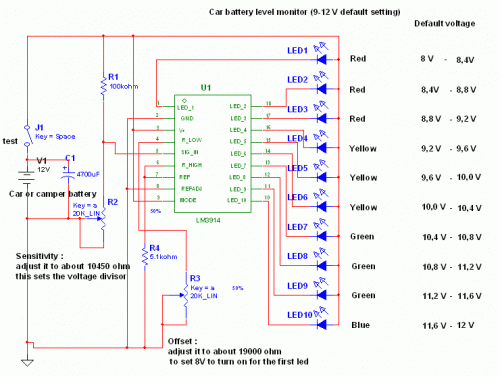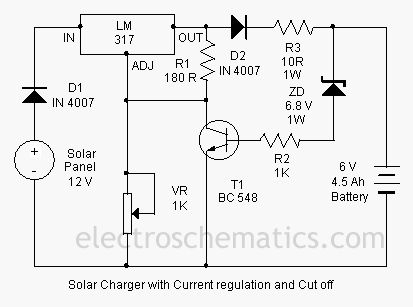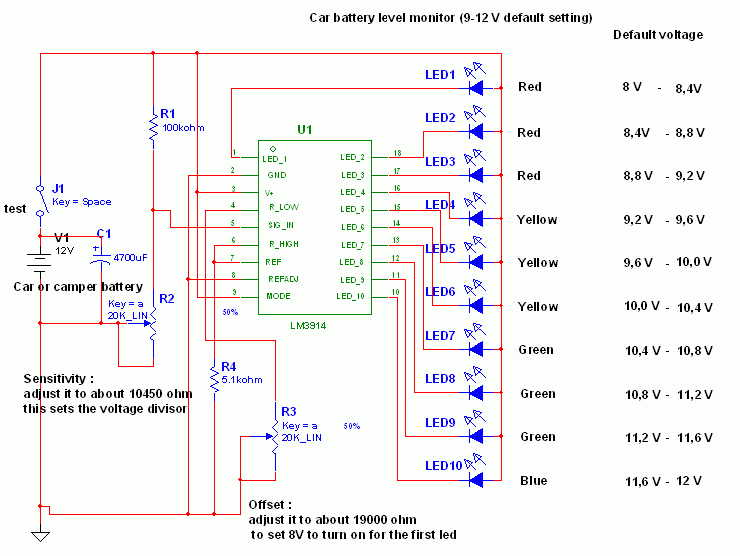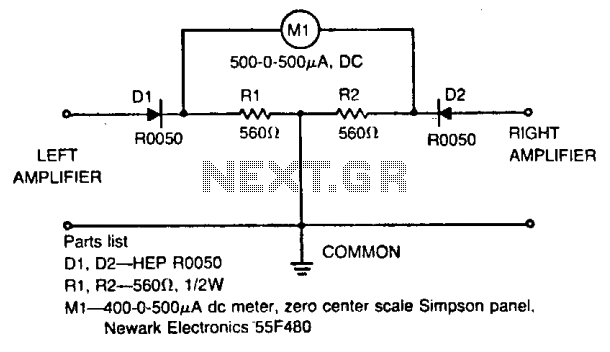
connection tester schematics
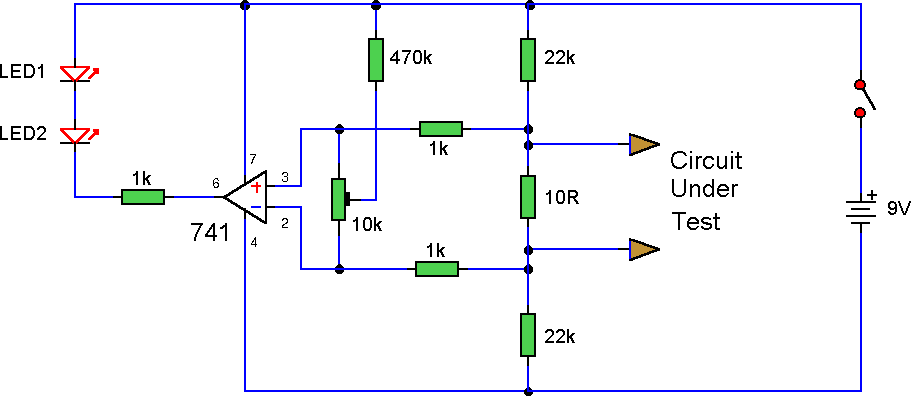
This simple circuit employs a 741 operational amplifier (op-amp) in differential mode to function as a continuity tester. The voltage difference between the non-inverting and inverting inputs is amplified by the full open-loop gain of the op-amp. Initially, ignore the 470kΩ and 10kΩ controls and focus on the op-amp inputs. If the resistors are perfectly matched, the voltage difference would be zero, resulting in a zero output. However, the inclusion of the 470kΩ and 10kΩ controls allows a small potential difference to be applied across the op-amp inputs, disrupting the circuit's balance. This potential difference is amplified, causing the op-amp output to swing to the full supply voltage, thereby illuminating the LEDs. The probes should first be connected to a resistor with a value between 0.22Ω and 4Ω. The control is adjusted until the LEDs just light up with the resistance across the probes. Afterward, the resistor should be removed, and the probes should be short-circuited; the LEDs should extinguish. Given the extremely low resistance value, it is crucial to keep the probes—whether crocodile clips or needles—clean, as dirt can increase contact resistance and lead to circuit malfunctions. The circuit is also compatible with MOSFET-type op-amps such as CA3130, CA3140, and JFET types like LF351. If the LEDs do not extinguish, a 10kΩ preset should be connected across the offset null terminals (pins 1 and 5), with the wiper of the control linked to the negative battery terminal.
This circuit functions as a practical tool for testing continuity in electrical components. The 741 op-amp, configured in differential mode, allows for the detection of small voltage differences, which is critical for identifying open circuits or poor connections. The operational amplifier's high gain ensures that even minor discrepancies in resistance can be amplified to a level that activates the output indicator, in this case, LEDs.
The use of a resistor in the range of 0.22Ω to 4Ω serves to provide a reference point for the circuit. Adjusting the 10kΩ control allows the user to calibrate the sensitivity of the circuit, ensuring that the LEDs light up only when a valid connection is detected. This calibration step is essential for accurate testing, as it compensates for any minor variations in the op-amp's characteristics or the test environment.
The recommendation to maintain clean probes is paramount, as increased contact resistance can lead to false readings. This aspect is particularly important in practical applications where the circuit may be used in environments with dust or moisture, which can compromise performance.
The circuit's versatility is enhanced by its compatibility with various op-amps, including MOSFET and JFET types. This allows for flexibility in design, enabling the user to select an op-amp that meets specific application requirements or availability. The addition of a preset resistor across the offset null terminals provides a means to fine-tune the circuit, ensuring reliable operation under varying conditions.
Overall, this continuity tester circuit is a valuable tool for electronics professionals, providing a straightforward and effective means of verifying the integrity of electrical connections.This simple circuit uses a 741 op-amp in differential mode as a continuity tester. The voltage difference between the non-inverting and inverting inputs is amplified by the full open loop gain of the op-amp. Ignore the 470k and the 10k control for the moment, and look at the input of the op-amp. If the resistors were perfectly matched, then the vo ltage difference would be zero and output zero. However the use of the 470k and 10k control allows a small potential difference to be applied across the op-amp inputs and upset the balance of the circuit. This is amplified causing the op-amp output to swing to full supply voltage and light the LED`s. The probes should first be connected to a resistor of value between 0. 22 ohm and 4ohm. The control is adjusted until the LED`s just light with the resistance across the probes. The resistor should then be removed and probes short circuited, the LED`s should go out. As the low resistance value is extremely low, it is important that the probes, (whether crocodile clips or needles etc) be kept clean, otherwise dirt can increase contact resistance and cause the circuit to mis-operate.
The circuit should also work with a MOSFET type op-amp such as CA3130, CA3140, and JFET types, e. g. LF351. If the lED`s will not extinguish then a 10k preset should be wired across the offset null terminals, pins 1 and 5, the wiper of the control being connected to the negative battery terminal. 🔗 External reference
This circuit functions as a practical tool for testing continuity in electrical components. The 741 op-amp, configured in differential mode, allows for the detection of small voltage differences, which is critical for identifying open circuits or poor connections. The operational amplifier's high gain ensures that even minor discrepancies in resistance can be amplified to a level that activates the output indicator, in this case, LEDs.
The use of a resistor in the range of 0.22Ω to 4Ω serves to provide a reference point for the circuit. Adjusting the 10kΩ control allows the user to calibrate the sensitivity of the circuit, ensuring that the LEDs light up only when a valid connection is detected. This calibration step is essential for accurate testing, as it compensates for any minor variations in the op-amp's characteristics or the test environment.
The recommendation to maintain clean probes is paramount, as increased contact resistance can lead to false readings. This aspect is particularly important in practical applications where the circuit may be used in environments with dust or moisture, which can compromise performance.
The circuit's versatility is enhanced by its compatibility with various op-amps, including MOSFET and JFET types. This allows for flexibility in design, enabling the user to select an op-amp that meets specific application requirements or availability. The addition of a preset resistor across the offset null terminals provides a means to fine-tune the circuit, ensuring reliable operation under varying conditions.
Overall, this continuity tester circuit is a valuable tool for electronics professionals, providing a straightforward and effective means of verifying the integrity of electrical connections.This simple circuit uses a 741 op-amp in differential mode as a continuity tester. The voltage difference between the non-inverting and inverting inputs is amplified by the full open loop gain of the op-amp. Ignore the 470k and the 10k control for the moment, and look at the input of the op-amp. If the resistors were perfectly matched, then the vo ltage difference would be zero and output zero. However the use of the 470k and 10k control allows a small potential difference to be applied across the op-amp inputs and upset the balance of the circuit. This is amplified causing the op-amp output to swing to full supply voltage and light the LED`s. The probes should first be connected to a resistor of value between 0. 22 ohm and 4ohm. The control is adjusted until the LED`s just light with the resistance across the probes. The resistor should then be removed and probes short circuited, the LED`s should go out. As the low resistance value is extremely low, it is important that the probes, (whether crocodile clips or needles etc) be kept clean, otherwise dirt can increase contact resistance and cause the circuit to mis-operate.
The circuit should also work with a MOSFET type op-amp such as CA3130, CA3140, and JFET types, e. g. LF351. If the lED`s will not extinguish then a 10k preset should be wired across the offset null terminals, pins 1 and 5, the wiper of the control being connected to the negative battery terminal. 🔗 External reference
